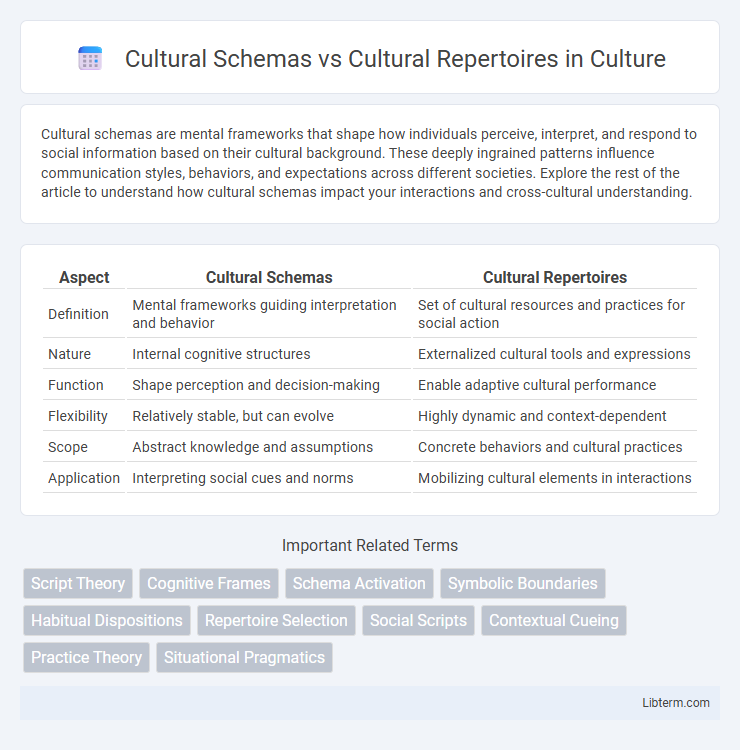Cultural schemas are mental frameworks that shape how individuals perceive, interpret, and respond to social information based on their cultural background. These deeply ingrained patterns influence communication styles, behaviors, and expectations across different societies. Explore the rest of the article to understand how cultural schemas impact your interactions and cross-cultural understanding.
Table of Comparison
| Aspect | Cultural Schemas | Cultural Repertoires |
|---|---|---|
| Definition | Mental frameworks guiding interpretation and behavior | Set of cultural resources and practices for social action |
| Nature | Internal cognitive structures | Externalized cultural tools and expressions |
| Function | Shape perception and decision-making | Enable adaptive cultural performance |
| Flexibility | Relatively stable, but can evolve | Highly dynamic and context-dependent |
| Scope | Abstract knowledge and assumptions | Concrete behaviors and cultural practices |
| Application | Interpreting social cues and norms | Mobilizing cultural elements in interactions |
Introduction to Cultural Schemas and Repertoires
Cultural schemas are cognitive structures that organize knowledge and guide perception, behavior, and interpretation within a cultural context, serving as mental frameworks shaped by collective experiences and shared meanings. Cultural repertoires refer to the diverse range of cultural resources, including practices, symbols, and narratives, that individuals draw upon to navigate social interactions and express identity. Understanding the distinction between schemas and repertoires highlights how internalized cognitive models interact with externalized cultural performances in shaping human behavior.
Defining Cultural Schemas
Cultural schemas are mental frameworks that help individuals organize and interpret cultural information, shaping perceptions, behaviors, and social interactions. These schemas consist of shared knowledge, beliefs, and expectations within a culture that guide understanding and decision-making in various contexts. Defined by cognitive anthropology, cultural schemas influence how cultural norms and values are internalized and enacted across different social settings.
Understanding Cultural Repertoires
Cultural repertoires encompass a range of culturally learned behaviors, skills, and symbolic resources that individuals draw upon in diverse social situations. These repertoires are flexible and context-dependent, allowing people to navigate varying cultural contexts by selectively activating different patterns of meaning and practice. Understanding cultural repertoires highlights how culture operates as an adaptable toolkit rather than a fixed set of rules, emphasizing the dynamic interplay between individual agency and collective cultural knowledge.
Historical Development of Both Concepts
Cultural schemas, rooted in cognitive anthropology and developed prominently by scholars like Jean Piaget and Bradd Shore, emphasize mental structures that guide perception and behavior based on shared cultural knowledge. The concept of cultural repertoires emerged from sociological and linguistic traditions, especially through the work of Ann Swidler in the 1980s, highlighting flexible sets of cultural tools individuals draw upon to navigate social situations. Historically, cultural schemas focus on internalized, stable patterns, while cultural repertoires underscore adaptable, situational strategies within cultural practices.
Key Differences Between Schemas and Repertoires
Cultural schemas are cognitive structures that represent generalized knowledge or mental frameworks about cultural norms, values, and practices, guiding individuals' perceptions and behaviors. Cultural repertoires consist of a broader range of learned behaviors, skills, and resources that individuals draw upon contextually to navigate cultural situations. The key difference lies in schemas being internalized mental models shaping interpretation, while repertoires are flexible sets of actions and competencies used adaptively across diverse cultural contexts.
How Cultural Schemas Shape Perceptions
Cultural schemas shape perceptions by providing mental frameworks that guide individuals in interpreting social cues and experiences according to shared cultural knowledge. These schemas influence how people categorize information, anticipate behavior, and respond to their environment, reinforcing collective meaning and social norms. Unlike cultural repertoires, which represent a range of possible behaviors, cultural schemas offer structured, deeply ingrained templates that shape consistent patterns of perception and understanding.
The Role of Cultural Repertoires in Social Action
Cultural repertoires serve as dynamic toolkits of norms, practices, and symbols that individuals draw upon to navigate social contexts and interactions effectively. They provide adaptable frameworks enabling people to select culturally appropriate behaviors and strategies in varying situations, thus facilitating coordinated social action. Unlike fixed cultural schemas, repertoires emphasize flexibility and agency, highlighting how culture shapes and is shaped by ongoing social practices.
Examples Across Societies
Cultural schemas are mental frameworks that guide individuals' understanding and behavior based on shared knowledge within a society, such as the concept of hospitality in Middle Eastern cultures or individualism in the United States. Cultural repertoires encompass the range of practices and strategies individuals employ, like the varied social greetings across Japan involving bowing versus handshakes in Western contexts. Examples across societies reveal that while cultural schemas provide foundational beliefs, cultural repertoires allow flexibility in social interactions adapted to specific contexts.
Implications for Intercultural Communication
Cultural schemas, as mental frameworks guiding perception and behavior, shape individuals' interpretations of intercultural interactions, while cultural repertoires provide a flexible set of practices enabling adaptive responses across diverse cultural contexts. Misalignment between a communicator's cultural schemas and another's cultural repertoires can lead to misunderstandings, affecting message decoding and intent recognition. Awareness of both constructs enhances intercultural competence by fostering empathy and improving communication strategies for effective cross-cultural engagement.
Conclusion: Integrating Schemas and Repertoires
Integrating cultural schemas and cultural repertoires enables a comprehensive understanding of how individuals navigate social contexts through shared cognitive frameworks and flexible behavioral options. Cultural schemas provide structured mental models that guide interpretation and meaning-making, while cultural repertoires offer a dynamic set of practices and resources for adapting to changing environments. This integration highlights the interplay between stable cultural knowledge and adaptive cultural expression, crucial for nuanced analyses in anthropology, sociology, and intercultural communication.
Cultural Schemas Infographic

 libterm.com
libterm.com